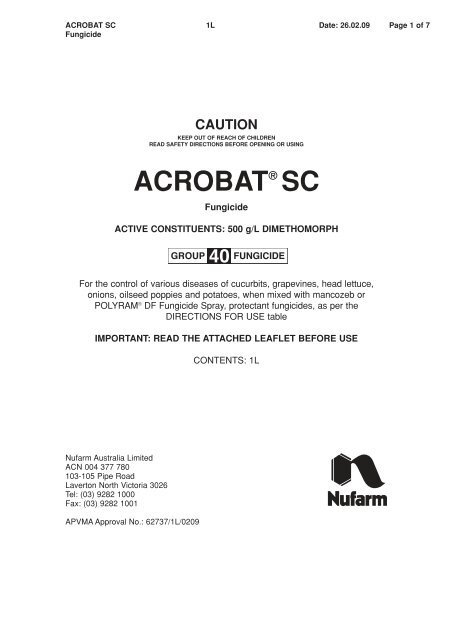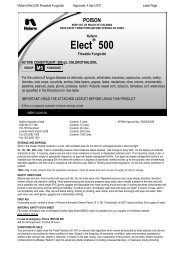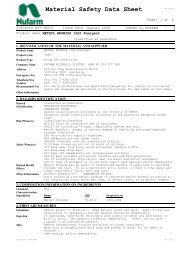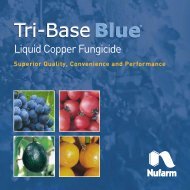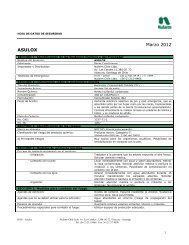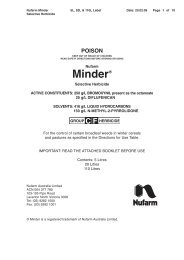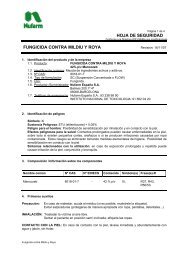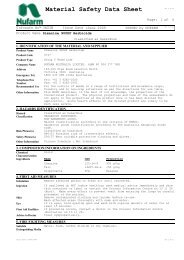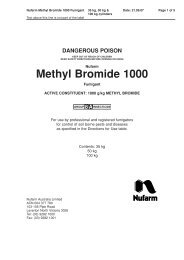You also want an ePaper? Increase the reach of your titles
YUMPU automatically turns print PDFs into web optimized ePapers that Google loves.
<strong>ACROBAT</strong> <strong>SC</strong> 1L Date: 26.02.09 Page 1 of 7<br />
<strong>Fungicide</strong><br />
CAUTION<br />
KEEP OUT OF REACH OF CHILDREN<br />
READ SAFETY DIRECTIONS BEFORE OPENING OR USING<br />
<strong>ACROBAT</strong> ® <strong>SC</strong><br />
<strong>Fungicide</strong><br />
ACTIVE CONSTITUENTS: 500 g/L DIMETHOMORPH<br />
For the control of various diseases of cucurbits, grapevines, head lettuce,<br />
onions, oilseed poppies and potatoes, when mixed with mancozeb or<br />
POLYRAM ® DF <strong>Fungicide</strong> Spray, protectant fungicides, as per the<br />
DIRECTIONS FOR USE table<br />
IMPORTANT: READ THE ATTACHED LEAFLET BEFORE USE<br />
CONTENTS: 1L<br />
<strong>Nufarm</strong> Australia Limited<br />
ACN 004 377 780<br />
103-105 Pipe Road<br />
Laverton North Victoria 3026<br />
Tel: (03) 9282 1000<br />
Fax: (03) 9282 1001<br />
APVMA Approval No.: 62737/1L/0209
<strong>ACROBAT</strong> <strong>SC</strong> 1L Date: 26.02.09 Page 2 of 7<br />
<strong>Fungicide</strong><br />
STORAGE AND DISPOSAL<br />
Store in the closed, original container in a cool, wellventilated<br />
area. DO NOT store for prolonged periods<br />
in direct sunlight.<br />
Triple or preferably pressure rinse containers before<br />
disposal. Add rinsings to spray tank. DO NOT dispose<br />
of undiluted chemicals on-site. If not recycling, break,<br />
crush or puncture and deliver empty packaging to an<br />
approved waste management facility. DO NOT burn<br />
empty containers or product.<br />
SAFETY DIRECTIONS<br />
Harmful if swallowed. When opening the container,<br />
preparing spray and using the prepared spray, wear<br />
cotton overalls buttoned to the neck and wrist (or<br />
equivalent clothing), a washable hat and elbow-length<br />
chemical resistant gloves. Wash hands after use.<br />
After each day’s use, wash gloves and contaminated<br />
clothing.<br />
FIRST AID<br />
If poisoning occurs, contact a doctor or Poisons<br />
Information Centre. Phone Australia 131126.<br />
MATERIAL SAFETY DATA SHEET<br />
For further information refer to the Material Safety<br />
Data Sheet (MSDS), which can be obtained from<br />
your supplier or from the <strong>Nufarm</strong> website –<br />
www.nufarm.com.au<br />
CONDITIONS OF SALE<br />
“Any provisions or rights under the Trade Practices<br />
Act 1974 or relevant state legislation which cannot be<br />
excluded by those statutes or by law are not intended<br />
to be excluded by these conditions of sale. Subject to<br />
the foregoing, all warranties, conditions, rights and<br />
remedies, expressed or implied under common law,<br />
statute or otherwise, in relation to the sale, supply,<br />
use or application of this product, are excluded.<br />
<strong>Nufarm</strong> Australia Limited and/or its affiliates<br />
(“<strong>Nufarm</strong>”) shall not accept any liability whatsoever<br />
(including consequential loss), or howsoever arising<br />
(including negligence) for any damage, injury or death<br />
connected with the sale, supply, use or application of<br />
this product except for liability which cannot be<br />
excluded by statute.”<br />
In case of emergency: Phone 1800 033 498<br />
Ask for shift supervisor. Toll free 24 hours.<br />
® = Registered trademarks of BASF<br />
© BASF, 2007<br />
Product No.:<br />
Batch No.:<br />
Date of Manufacture:
<strong>ACROBAT</strong> <strong>SC</strong> Leaflet Date: 26.02.09 Page 3 of 7<br />
<strong>Fungicide</strong><br />
CAUTION<br />
KEEP OUT OF REACH OF CHILDREN<br />
READ SAFETY DIRECTIONS BEFORE OPENING OR USING<br />
<strong>ACROBAT</strong> ® <strong>SC</strong><br />
<strong>Fungicide</strong><br />
ACTIVE CONSTITUENTS: 500 g/L DIMETHOMORPH<br />
For the control of various diseases of cucurbits, grapevines, head lettuce,<br />
onions, oilseed poppies and potatoes, when mixed with mancozeb or<br />
POLYRAM ® DF <strong>Fungicide</strong> Spray, protectant fungicides, as per the<br />
DIRECTIONS FOR USE table<br />
IMPORTANT: THIS BOOKLET IS PART OF THE LABEL<br />
<strong>Nufarm</strong> Australia Limited<br />
ACN 004 377 780<br />
103-105 Pipe Road<br />
Laverton North Victoria 3026<br />
Tel: (03) 9282 1000<br />
Fax: (03) 9282 1001<br />
APVMA Approval No.: 62737/0209
<strong>ACROBAT</strong> <strong>SC</strong> Leaflet Date: 26.02.09 Page 4 of 7<br />
<strong>Fungicide</strong><br />
DIRECTIONS FOR USE<br />
RESTRAINTS: DO NOT apply by aircraft.<br />
CROP<br />
DISEASE<br />
RATE<br />
WHP<br />
CRITICAL COMMENTS<br />
Cucurbits<br />
Downy mildew<br />
(Pseudoperonospora<br />
cubensis)<br />
Qld and NT only<br />
Anthracnose<br />
(Colletotrichum spp.),<br />
Gummy stem blight<br />
(Didymella bryoniae),<br />
Alternaria leaf spot<br />
(Alternaria spp.),<br />
Septoria spot<br />
(pumpkin)<br />
(Septoria spp.)<br />
360 mL/ha plus<br />
mancozeb (1.5<br />
kg/ha of<br />
mancozeb 800<br />
or 1.6 kg/ha of<br />
mancozeb 750)<br />
or plus<br />
POLYRAM at<br />
2.2 kg/ha<br />
7 days<br />
Maintain a regular protectant spray programme. Apply<br />
<strong>ACROBAT</strong> <strong>SC</strong> when conditions favour disease development<br />
but before the disease is evident. Apply two consecutive<br />
sprays of <strong>ACROBAT</strong> <strong>SC</strong>, 7 to 10 days apart, then change to<br />
a fungicide from another chemical group. Use the shorter<br />
interval when conditions favouring infection are creating a<br />
high risk. Add a non-ionic surfactant at label rate. Ensure that<br />
good coverage is achieved, including the undersides of<br />
leaves.<br />
DO NOT apply more than 4 sprays of <strong>ACROBAT</strong> <strong>SC</strong> to each<br />
crop, as a precaution against development of disease<br />
resistance.<br />
NOTE: In some states, POLYRAM can only be used on<br />
cucumbers and not other cucurbits. (Refer to POLYRAM label<br />
for full details)<br />
Grapevines<br />
Downy mildew<br />
(Plasmopara viticola)<br />
Dilute<br />
spraying<br />
36 mL/100 L<br />
plus mancozeb<br />
(120 g/100 L of<br />
mancozeb 800<br />
or 160 g/100 L<br />
of mancozeb<br />
750) or plus<br />
POLYRAM at<br />
150 to 200<br />
g/100 L<br />
Concentrate<br />
spraying<br />
Refer to the<br />
Application<br />
section<br />
4 weeks<br />
DO NOT use in crops intended for drying.<br />
Also see ‘PRECAUTION’ section re export commodities.<br />
Apply at 7 to 14 day intervals when humid or wet conditions<br />
favour infection but before disease is evident. Use the shorter<br />
interval when conditions favouring infection are creating a<br />
high risk. Apply a maximum of 3 consecutive sprays before<br />
changing to another fungicide.<br />
Apply by dilute or concentrate spraying equipment.<br />
Apply the same total amount of product to the target crop<br />
whether applying this product by dilute or concentrate<br />
spraying methods.<br />
DO NOT use concentrate spraying equipment that requires a<br />
concentration factor of more than 5X (180mL/100L). DO NOT<br />
apply in volumes less than 250 L/ha.<br />
Add a non-ionic wetting agent. DO NOT apply more than 6<br />
sprays of <strong>ACROBAT</strong> <strong>SC</strong> per season, as a precaution against<br />
development of disease resistance.<br />
DO NOT use a tankmix with POLYRAM on vines in ACT or<br />
NT. (Refer to POLYRAM label for full details)<br />
Lettuce (head<br />
varieties only)<br />
Downy mildew<br />
(Bremia lactucae),<br />
Anthracnose<br />
(Marssonina<br />
panattoniana),<br />
Septoria leaf spot<br />
(Septoria spp.)<br />
360 mL/ha plus<br />
mancozeb (1.5<br />
kg/ha of<br />
mancozeb 800<br />
or 1.6 kg/ha of<br />
mancozeb 750)<br />
or plus<br />
POLYRAM at<br />
2.2 kg/ha<br />
14 days<br />
Maintain a regular protectant spray programme. Apply when<br />
conditions favour disease development but before the<br />
disease is evident. Apply two consecutive sprays of<br />
<strong>ACROBAT</strong> <strong>SC</strong>, 7 to 10 days apart, then change to a<br />
fungicide from another chemical group. Use the shorter<br />
interval when conditions favouring infection are creating a<br />
high risk. Apply in 250 to 500 L of water per hectare. Add a<br />
non-ionic surfactant at label rates. DO NOT apply more than<br />
4 sprays of <strong>ACROBAT</strong> <strong>SC</strong> to each crop as a precaution<br />
against development of disease resistance.<br />
Oilseed<br />
poppies<br />
Downy mildew<br />
(Peronospora<br />
arborescens)<br />
360 mL/ha plus<br />
mancozeb<br />
(1.5kg/ha of<br />
mancozeb 800)<br />
6 weeks<br />
Maintain a protective spray programme at early run-up stage<br />
of crop growth. Apply <strong>ACROBAT</strong> <strong>SC</strong> when conditions favour<br />
disease development during the late run-up to hook stage.<br />
Re-apply 10 days later if required. Apply in 250 to 500 L<br />
water per hectare. Add a non-ionic surfactant at the label<br />
rate. DO NOT apply later than early flowering stage. DO NOT<br />
apply more than 2 sprays of <strong>ACROBAT</strong> <strong>SC</strong> to each crop, as a<br />
precaution against development of disease resistance.<br />
Onions<br />
Downy mildew<br />
(Peronospora<br />
destructor),<br />
leaf blight<br />
Qld and NT only<br />
Purple blotch<br />
(Alternaria porri)<br />
360 mL/ha plus<br />
mancozeb (1.5<br />
kg/ha of<br />
mancozeb 800<br />
or 1.6 kg/ha of<br />
mancozeb 750)<br />
7 days<br />
Maintain a regular protectant spray programme. Apply when<br />
conditions favour disease development but before the<br />
disease is evident. Apply two consecutive sprays of<br />
<strong>ACROBAT</strong> <strong>SC</strong>, 7 to 14 days apart, then change to a<br />
fungicide from another chemical group. Use the shorter<br />
interval when conditions favouring infection are creating a<br />
high risk. Apply in 250 to 500 L of water per hectare. Add a<br />
non-ionic surfactant at the label rate. DO NOT apply more<br />
than 4 sprays of <strong>ACROBAT</strong> <strong>SC</strong> to each crop, as a precaution<br />
against development of disease resistance.
<strong>ACROBAT</strong> <strong>SC</strong> Leaflet Date: 26.02.09 Page 5 of 7<br />
<strong>Fungicide</strong><br />
CROP<br />
DISEASE<br />
RATE<br />
WHP<br />
CRITICAL COMMENTS<br />
Potatoes<br />
Late blight<br />
(Phytophthora<br />
infestans),<br />
early blight<br />
(Alternaria solani)<br />
360 mL/ha plus<br />
mancozeb (1.5<br />
kg/ha of<br />
mancozeb 800<br />
or 1.6 kg/ha of<br />
mancozeb 750)<br />
or plus<br />
POLYRAM at<br />
1.7 to 2.5 kg/ha<br />
14 days<br />
Maintain a regular protectant spray programme. Apply on a<br />
protectant schedule at 7 to 10 day intervals when conditions<br />
favour disease development but before the disease is<br />
evident. Use the shorter spray interval when conditions for<br />
disease development are severe. Add a non-ionic surfactant<br />
at the label rate. Apply <strong>ACROBAT</strong> <strong>SC</strong> in 250 to 500 L of<br />
water per hectare. DO NOT apply more than 4 sprays of<br />
<strong>ACROBAT</strong> <strong>SC</strong> to each crop, as a precaution against<br />
development of disease resistance.<br />
NOT TO BE USED FOR ANY PURPOSE, OR IN ANY MANNER, CONTRARY TO THIS LABEL UNLESS<br />
AUTHORISED UNDER APPROPRIATE LEGISLATION.<br />
WITHHOLDING PERIODS:<br />
CUCURBITS, ONIONS:<br />
LETTUCE (HEAD<br />
VARIETIES ONLY),<br />
POTATOES:<br />
GRAPEVINES:<br />
OILSEED POPPIES:<br />
DO NOT HARVEST FOR 7 DAYS AFTER APPLICATION.<br />
DO NOT HARVEST FOR 14 DAYS AFTER APPLICATION.<br />
DO NOT HARVEST FOR 4 WEEKS AFTER APPLICATION.<br />
DO NOT HARVEST FOR 6 WEEKS AFTER APPLICATION.
<strong>ACROBAT</strong> <strong>SC</strong> Leaflet Date: 26.02.09 Page 6 of 7<br />
<strong>Fungicide</strong><br />
GENERAL INSTRUCTIONS<br />
FUNGICIDE RESISTANCE WARNING<br />
For fungicide resistance management, <strong>ACROBAT</strong> <strong>SC</strong><br />
is a Group 40 fungicide.<br />
Some naturally occurring individual fungi resistant to<br />
<strong>ACROBAT</strong> <strong>SC</strong> may exist through normal genetic<br />
variability in any fungal population. The resistant<br />
individuals can eventually dominate the fungal<br />
population if <strong>ACROBAT</strong> <strong>SC</strong> is used repeatedly. These<br />
resistant fungi may not be controlled by <strong>ACROBAT</strong> <strong>SC</strong><br />
and other Group 40 fungicides, thus resulting in a<br />
reduction in efficacy and possible yield loss.<br />
Since the occurrence of resistant fungi is difficult to<br />
detect prior to use, <strong>Nufarm</strong> Australia Ltd accepts no<br />
liability for any losses that may result from the failure<br />
of <strong>ACROBAT</strong> <strong>SC</strong> to control resistant fungi.<br />
For resistance management, this product should<br />
always be used in conjunction with mancozeb or<br />
POLYRAM. These mixtures combine the locally<br />
systemic, translaminar properties of dimethomorph<br />
with the protective properties of products such as<br />
mancozeb and POLYRAM. It should always be used<br />
as part of a protective spray programme and applied<br />
before disease symptoms appear. To prevent or delay<br />
the development of strains of disease fungi resistant<br />
to dimethomorph, it is recommended that this product<br />
is used in spray programmes including fungicides with<br />
different modes of action. Refer to the CRITICAL<br />
COMMENTS section of this label. Consult a <strong>Nufarm</strong><br />
representative for further information if required.<br />
PRECAUTION<br />
Export of treated fruit or wine<br />
Growers should note that Maximum Residue Limits<br />
(MRLs) or import tolerances do not exist in all markets<br />
for fruit treated with <strong>ACROBAT</strong> <strong>SC</strong> <strong>Fungicide</strong>.<br />
Additionally, some export markets have established<br />
MRLs different to those in Australia. If you are growing<br />
fruit for export (either fresh or as wine), please check<br />
with <strong>Nufarm</strong> Australia Ltd or the Australian Wine<br />
Research Institute http://www.awri.com.au for the<br />
latest information on MRLs and import tolerances<br />
BEFORE using <strong>ACROBAT</strong> <strong>Fungicide</strong>.<br />
RE-ENTRY PERIOD<br />
DO NOT allow entry into treated areas until the spray<br />
has dried. When prior entry is necessary, wear cotton<br />
overalls buttoned to the neck and wrist and a<br />
washable hat and chemical resistant gloves. Clothing<br />
must be laundered after each day’s use.<br />
MIXING<br />
Half fill the spray vat with water and commence<br />
agitation. Add the required volume of <strong>ACROBAT</strong> <strong>SC</strong><br />
and allow to disperse. Add the correct amount of<br />
mancozeb or POLYRAM as directed. Add the<br />
remainder of the water with agitation running. Add<br />
wetting agent, if required, when spray tank is full.<br />
Ensure thorough mixing and constant agitation to<br />
keep the product in suspension.<br />
APPLICATION<br />
Ensure thorough coverage of plants, especially the<br />
underside of leaves and young grape bunches.<br />
DO NOT apply by aircraft.<br />
APPLICATION TO GRAPEVINES<br />
Dilute spraying<br />
• Use a sprayer designed to apply high volumes of<br />
water up to the point of run-off and matched to the<br />
crop being sprayed.<br />
• Set up and operate the sprayer to achieve even<br />
coverage throughout the crop canopy. Apply<br />
sufficient water to cover the crop to the point of<br />
run-off. Avoid excessive run-off.<br />
• The required water volume may be determined by<br />
applying different test volumes using different<br />
settings on the sprayer, from industry guidelines or<br />
expert advice.<br />
• Add the amount of product specified in the<br />
Directions for Use table for each 100 L of water.<br />
Spray to the point of run-off.<br />
• The required dilute spray volume will change and<br />
the sprayer set up and operation may also need to<br />
be changed as the crop grows.<br />
Concentrate spraying<br />
• Use a sprayer designed and set up for concentrate<br />
spraying (that is a sprayer which applies water<br />
volumes less than those required to reach the<br />
point of run-off) and matched to the crop being<br />
sprayed.<br />
• Set up and operate the sprayer to achieve even<br />
coverage throughout the crop canopy using your<br />
chosen water volume.<br />
• Determine an appropriate dilute spray volume (See<br />
Dilute Spraying above) for the crop canopy. This is<br />
needed to calculate the concentrate mixing rate.<br />
• The mixing rate for concentrate spraying can then<br />
be calculated in the following way:<br />
EXAMPLE ONLY<br />
1. Dilute spray volume as determined above: For<br />
example 1500 L/ha<br />
2. Your chosen concentrate spray volume: For<br />
example 500 L/ha<br />
3. The concentration factor in this example is: 3 X<br />
(i.e. 1500 L ÷ 500 L = 3)<br />
4. If the dilute label rate is 36 g/100 L, then the<br />
concentrate rate becomes 3 x 36, that is 108 g/<br />
100 L of concentrate spray.<br />
• The chosen spray volume, amount of product per<br />
100 L of water, and the sprayer set up and<br />
operation may need to be changed as the crop<br />
grows.<br />
• For further information on concentrate spraying,<br />
users are advised to consult relevant industry<br />
guidelines, undertake appropriate competency<br />
training and follow industry Best Practices.
<strong>ACROBAT</strong> <strong>SC</strong> Leaflet Date: 26.02.09 Page 7 of 7<br />
<strong>Fungicide</strong><br />
For concentrate application, use a spray volume of at<br />
least 250 litres per hectare.<br />
For dilute application, apply to run-off. See Dilute<br />
spraying above.<br />
COMPATIBILITY<br />
<strong>ACROBAT</strong> <strong>SC</strong> should always be mixed with<br />
mancozeb or POLYRAM as directed. Due to the<br />
range of mancozeb formulations available,<br />
compatibility has not been tested on all products.<br />
Users are advised to test the tank mix on a small<br />
area of the crop to be treated, prior to use.<br />
<strong>ACROBAT</strong> <strong>SC</strong> can be tank-mixed with MVP Bioencapsulated<br />
Insecticide, Dipel + Forte, Lorsban + EC,<br />
Kocide + or DELAN ® <strong>Fungicide</strong>.<br />
Avoid mixing with strongly alkaline or acidic materials.<br />
PROTECTION OF WILDLIFE, FISH,<br />
CRUSTACEANS AND ENVIRONMENT<br />
Highly toxic to fish and other aquatic organisms. DO<br />
NOT contaminate ponds, dams, streams, waterways<br />
or drains with the chemical or used containers.<br />
remedies, expressed or implied under common law,<br />
statute or otherwise, in relation to the sale, supply,<br />
use or application of this product, are excluded.<br />
<strong>Nufarm</strong> Australia Limited and/or its affiliates<br />
(“<strong>Nufarm</strong>”) shall not accept any liability whatsoever<br />
(including consequential loss), or howsoever arising<br />
(including negligence) for any damage, injury or death<br />
connected with the sale, supply, use or application of<br />
this product except for liability which cannot be<br />
excluded by statute.”<br />
In case of emergency: Phone 1800 033 498<br />
Ask for shift supervisor. Toll free 24 hours.<br />
® = Registered trademarks of BASF<br />
© BASF, 2007<br />
APVMA Approval No.: 62737/0209<br />
DO NOT apply under meteorological conditions or<br />
from spraying equipment which could be expected to<br />
cause spray to drift onto nearby susceptible plants,<br />
adjacent crops, crop lands or pastures.<br />
STORAGE AND DISPOSAL<br />
Store in the closed, original container in a cool, wellventilated<br />
area. DO NOT store for prolonged periods<br />
in direct sunlight.<br />
Triple or preferably pressure rinse containers before<br />
disposal. Add rinsings to spray tank. DO NOT dispose<br />
of undiluted chemicals on-site. If not recycling, break,<br />
crush or puncture and deliver empty packaging to an<br />
approved waste management facility. DO NOT burn<br />
empty containers or product.<br />
SAFETY DIRECTIONS<br />
Harmful if swallowed. When opening the container,<br />
preparing spray and using the prepared spray, wear<br />
cotton overalls buttoned to the neck and wrist (or<br />
equivalent clothing), a washable hat and elbow-length<br />
chemical resistant gloves. Wash hands after use.<br />
After each day’s use, wash gloves and contaminated<br />
clothing.<br />
FIRST AID<br />
If poisoning occurs, contact a doctor or Poisons<br />
Information Centre. Phone Australia 131126.<br />
MATERIAL SAFETY DATA SHEET<br />
For further information refer to the Material Safety<br />
Data Sheet (MSDS), which can be obtained from<br />
your supplier or from the <strong>Nufarm</strong> website –<br />
www.nufarm.com.au<br />
CONDITIONS OF SALE<br />
“Any provisions or rights under the Trade Practices<br />
Act 1974 or relevant state legislation which cannot be<br />
excluded by those statutes or by law are not intended<br />
to be excluded by these conditions of sale. Subject to<br />
the foregoing, all warranties, conditions, rights and


